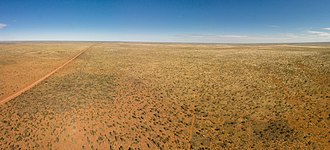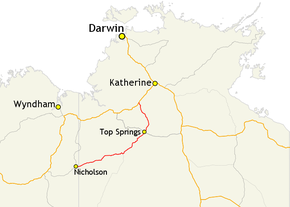Ricky Megee

Ricky Megee (born 1970/1971) is an Australian, most notable for having been stranded in the
Ricky Megee | |
|---|---|
| Nationality | |
Early life
Ricky Megee was born in 1970 or 1971 in
Journey to Port Hedland and attack

In January 2006
The events leading to Megee being stranded are somewhat confused, and indeed, Megee's version of how events unfolded changed significantly over time. He first told his rescuers that his car had broken down,
Later, in his 2010 autobiography,[8] Megee said that there had been three men sitting on the roadside, who had run out of petrol, and that he had offered to give one of them a lift to a petrol station.[1] Megee also posited that he could have been stabbed with a drugged-syringe during a struggle.[2] Either way, Megee later recalled feeling increasingly "dazed and confused", and then blacked out before he recovered consciousness hours later.[3] He also said that his attackers did not leave him immediately: they over-powered and stunned him. He later awoke in their camp. They had a gun, wrote Megee, but never used it; they did bring him water. After an unknown period, the carjackers lifted camp and disappeared.[1] Before they left, they stole his shoes,[9] but left him with $12.30 which had been in his pocket.[6]
When he regained consciousness, he said, he was in a hole, covered in black plastic, which had had "some rocks and dirt thrown on top".
Journey across the desert
I ate the leeches raw, straight out of the dam, grasshoppers I just ate them...But the only thing I really sort of had to cook was the frogs which (I) slipped onto a bit of wire and stuck the wire on top of my humpy, let the sun dry them out a fair bit until they were a bit crispy and then just ate them.
Ricky Megee talking to
Megee walked for ten days through the northeastern fringe of the Tanami Desert.[10] He often lost consciousness through heat exhaustion,[4] as temperatures regularly went above 40 °C (104 °F).[11] According to Mark Clifford, a local man who later witnessed Megee's arrival, although the temperatures were high, it was also the middle of the wet season during the time, which was in Megee's favour. When combined with the abundance of small wild animals and Megee's "hardy constitution", his chances of survival were, with hindsight, actually relatively good.[12] However, it was never clearly established precisely how Megee became as lost as he did.[3]
Megee said that he survived by eating
Megee—"baked in the day and frozen at night"[13]—created temporary shelters from the sun out of old branches, and eventually found a decrepit windmill.[1] Megee said that he made "a little humpy[note 1] out of a feed trough that was at some cattle yards, obviously a mustering point, I thought to myself, so I've dragged it up on top of the dam, flipped it over and dug a hole and just lived in there for 10 weeks."[15] Megee became dangerously weak, to the extent that he was unable to travel as far on his daily foraging expeditions.[13] At one point he suffered an abscess of the tooth that—weakened as he was—could have been fatal,[11] and which he prised out of his mouth with his car keys.[6]
Rescue and recovery
"It's a bit unclear what the trouble was with the car, and why he ended up off the road. He's walked for about 10 days to get to where he is before he's realised that he's got to set himself up some shelter and start trying to get some food into himself. He basically sat where he was for about 10 weeks.[10]
Mark Clifford, manager of the Birrindudu cattle station
Megee was eventually discovered about 50 kilometres (31 mi) from
On 5 April 2006
Aftermath

Megee's Challenger was never recovered,[3] and Megee himself lost 60 kilograms (130 lb),[3] or over half his original bodyweight,[4] which was over 100 kilograms (220 lb).[1]
The
Megee subsequently wrote a book on his experience and emigrated to Dubai[1] to work in construction.[16]
See also
Note
References
- ^ a b c d e f g h i j Lamparska 2012.
- ^ a b c d Squires 2006b.
- ^ a b c d e f g h i j k l m n o p q r Sydney Morning Herald 2006.
- ^ a b c d e f g h i j k l Colvin 2006.
- ^ a b c d e BBC News 2006.
- ^ a b c Rajok 2009.
- ^ a b Rupar & Fisher 2014.
- ^ Allen and Unwin 2010.
- ^ Megee & McLean 2008, p. 2.
- ^ a b c d Squires 2006a.
- ^ a b Polley 2018, p. 96.
- ^ a b c d Jones 2006.
- ^ a b c d e Mann & Pezzullo 2012, p. 106.
- ^ DAC 2018.
- ^ a b c Kerin 2006.
- ^ H&S 2009.
Bibliography
- Allen and Unwin (2010). "Left For Dead: How I Survived 71 Days Lost in a Desert Hell / Ricky Megee and Greg McLean". Allen and Unwin. Archived from the original on 20 August 2018. Retrieved 20 August 2018.
- BBC News (14 April 2006). "Outback 'skeleton' recalls ordeal". BBC. OCLC 33057671. Archived from the originalon 29 July 2018. Retrieved 29 June 2018.
- Colvin, M. (13 April 2006). "Drugged and abandoned in the outback: survivor claims". ABC News. Archived from the original on 29 July 2018. Retrieved 29 July 2018.
- Humpy. Oxford. 2018. ISBN 9780195563160. Archived from the original on 29 July 2018. Retrieved 29 July 2018.)
{{cite book}}:|website=ignored (help - "Left For Dead In The Outback". Hodder & Stoughton. 2009. Archived from the original on 29 July 2018. Retrieved 29 July 2018.
- Jones, S. (14 April 2006). "Man tells of surviving 70 days in outback on diet of frogs and snakes". The Guardian. OCLC 614761493. Archived from the originalon 29 July 2018. Retrieved 29 July 2018.
- Kerin, L. (13 April 2006). "Man survives in desert by eating frogs and lizards". ABC Radio. OCLC 762244169. Archived from the originalon 29 July 2018. Retrieved 29 July 2018.
- Lamparska, J. (29 December 2012). "71 dni bez jedzenia na australijskiej pustyni". National Geographic Polska. National Geographic. Archived from the original on 29 July 2018. Retrieved 29 July 2018.
- Mann, D.; Pezzullo, R. (2012). The U.S. Navy SEAL Survival Handbook: Learn the Survival Techniques and Strategies of America's Elite Warriors. New York: Skyhorse Publishing. ISBN 978-1-62087-393-9.
- Megee, R.; McLean, G. (2008). Left For Dead: How I Survived 71 Days Lost in a Desert Hell. Crow's Nest, NSW: Allen & Unwin. ISBN 978-1-74176-939-5.
- Polley, J. (2018). The Survival Manual. London: Hodder & Stoughton. ISBN 978-1-47367-490-5.
- Rajok, A. (23 April 2009). "Desert challenge". Gulf News. Retrieved 29 July 2018.
- Rupar, T.; Fisher, M. (4 January 2014). "Stranded: 9 amazing stories of survival against the odds". The Washington Post. Archived from the original on 8 September 2018. Retrieved 29 July 2018.
- Squires, N. (14 April 2006a). "Lost man survives in Outback on raw frogs and leeches". The Telegraph. OCLC 6412514. Archived from the originalon 29 July 2018. Retrieved 29 July 2018.
- Squires, N. (17 April 2006b). "Police take closer look at claims of Outback 'survivor'". South China Morning Post. OCLC 39674929. Archived from the originalon 29 July 2018. Retrieved 29 July 2018.
- Sydney Morning Herald (14 April 2006). "Outback survivor's leech and frog diet". Sydney Morning Herald. Archived from the original on 29 July 2018. Retrieved 29 July 2018.
